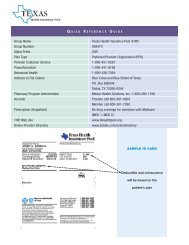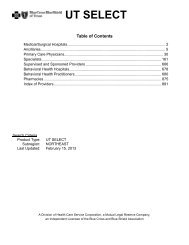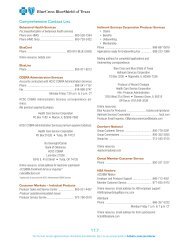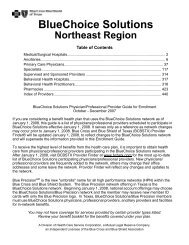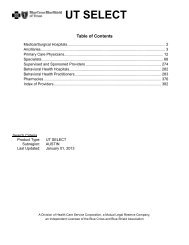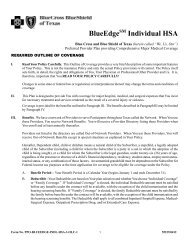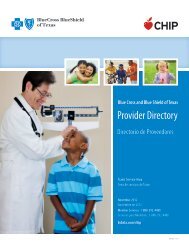Extracorporeal Membrane Oxygenation (ECMO) - Blue Cross Blue ...
Extracorporeal Membrane Oxygenation (ECMO) - Blue Cross Blue ...
Extracorporeal Membrane Oxygenation (ECMO) - Blue Cross Blue ...
Create successful ePaper yourself
Turn your PDF publications into a flip-book with our unique Google optimized e-Paper software.
EXTRACORPOREAL MEMBRANE OXYGENATION (<strong>ECMO</strong>)<br />
MED202.038<br />
<strong>Blue</strong>Review POSTED DATE: 11/17/2003<br />
EFFECTIVE DATE: 10/24/2003<br />
_____________________________________________________________________________<br />
COVERAGE:<br />
<strong>Extracorporeal</strong> <strong>Membrane</strong> <strong>Oxygenation</strong> (<strong>ECMO</strong>) may be considered medically<br />
necessary for coverage in neonates, infants, and children with cardiac<br />
or respiratory failure that is not expected to improve with<br />
conventional medical management. (medications and mechanical<br />
ventilation).<br />
<strong>ECMO</strong> is considered medically necessary as an adjunct to (or in post)<br />
lung transplantation for infants, children and adults.<br />
<strong>ECMO</strong> for adult patients, other than in post lung transplant, is<br />
considered experimental or investigational.<br />
______________________________________________________________________<br />
DESCRIPTION:<br />
<strong>ECMO</strong> is the use of a near total cardiopulmonary bypass on infants and<br />
children suffering from severe heart and lung failure. It is used when<br />
the condition is believed to be potentially reversible but has been<br />
unresponsive to more conventional medical management including<br />
medication and mechanical ventilation. <strong>ECMO</strong> supports the activities of<br />
the heart and lungs until the organs can recover function. The<br />
intervention is expected to be bridge therapy to function recovery and<br />
is not curative. <strong>ECMO</strong> is usually continued for three to twenty-one<br />
days depending on the severity of the infant or child’s condition. The<br />
decision to discontinue <strong>ECMO</strong> is made when evaluation of lung shows<br />
that oxygenation and carbon dioxide elimination can be safely<br />
supported with a conventional ventilator. Most infants and children<br />
require <strong>ECMO</strong> support for five to seven days but, the duration depends<br />
upon the severity of the lung and/or heart disease.<br />
“In lung transplantation, <strong>ECMO</strong> is utilized for respiratory support and<br />
stabilization. Typically, lung transplantation for pulmonary<br />
hypertension employs cardiopulmonary bypass with associated complete<br />
systemic anticoagulation, uncontrolled allograft reperfusion and<br />
aggressive ventilation. Intraoperative and prolonged post-operative<br />
use of <strong>ECMO</strong> allows avoidance of these factors and earlier allograft<br />
function recovery.”<br />
______________________________________________________________________<br />
RATIONALE:<br />
Current literature has expanded the age limits of <strong>ECMO</strong> from the use of<br />
neonates only, to include infants over 30 days of age, and children<br />
with cardiac and respiratory failure. These limits have been expanded<br />
due to new technology within the <strong>ECMO</strong> system which limits the amount<br />
of heparinization necessary, therefore, limiting the problems with<br />
bleeding experienced in past studies. Research has shown that <strong>ECMO</strong><br />
<strong>Blue</strong> <strong>Cross</strong> and <strong>Blue</strong> Shield of Texas, a Division of Health Care Service Corporation, a Mutual Legal Reserve Company*<br />
Southwest Texas HMO, Inc.* d/b/a HMO <strong>Blue</strong> ® Texas<br />
* Independent Licensees of the <strong>Blue</strong> <strong>Cross</strong> and <strong>Blue</strong> Shield Association
EXTRACORPOREAL MEMBRANE OXYGENATION (<strong>ECMO</strong>)<br />
MED202.038<br />
<strong>Blue</strong>Review POSTED DATE: 11/17/2003<br />
EFFECTIVE DATE: 10/24/2003<br />
_____________________________________________________________________________<br />
does not cure lung or heart disease, but that it provides support for<br />
the infant or child to allow the organs to heal.<br />
Current literature supports the use of <strong>ECMO</strong> for intra- and<br />
postoperatively prolonged support of lung transplantation for<br />
pulmonary hypertension. <strong>ECMO</strong> support provides excellent initial organ<br />
function due to optimal controlled reperfusion and non aggressive<br />
ventilation. This results in improved outcomes even in advanced forms<br />
of pulmonary hypertension.<br />
Current literature does not support <strong>ECMO</strong> for the treatment of cardiac<br />
and/or respiratory failure in adult patients, (other than lung trans-<br />
plantation). This documentation does not verify the same improvement<br />
in post <strong>ECMO</strong> outcomes for adults, as has been shown with infants and<br />
children. The decrease in heparinization and the improvements in <strong>ECMO</strong><br />
technology do not show a significant change in the tendency toward<br />
bleeding and thrombus development in adult patients. Additional study<br />
is needed.<br />
______________________________________________________________________<br />
PRICING:<br />
<strong>ECMO</strong> is paid as a separate service from pediatric and neonatal<br />
critical care evaluation and management services.<br />
______________________________________________________________________<br />
REFERENCES:<br />
• “<strong>Extracorporeal</strong> <strong>Membrane</strong> <strong>Oxygenation</strong>,” BCBSA TEC Evaluation,<br />
(May 1987) 74-82.<br />
• Don, S.M. “<strong>ECMO</strong> indications and complications” Hospital Practice<br />
(Office Edition) (1990 June 15) 143-57.<br />
• Zwischenberger, J.B., Null, D., et al. “Neonatal extracorporeal<br />
membrane oxygenation in Texas.” The Journal of Texas Medicine (Texas<br />
Medicine) (1990 August) 86(8): 72-78.<br />
• “<strong>Extracorporeal</strong> <strong>Membrane</strong> <strong>Oxygenation</strong>,” BCBSA Uniform Medical Policy<br />
Manual, Medicine, (1994 March) 33960.0.<br />
• Glassman, L.R., Keenan, R.J., et al. “<strong>Extracorporeal</strong> membrane<br />
oxygenation as an adjunct treatment for primary graft failure in<br />
adult lung transplant recipients.” Journal of Thoracic and<br />
Cardiovascular Surgery (1995 September) 110(3): 723-7.<br />
• Zenati, M., Pham, S.M., et al. “<strong>Extracorporeal</strong> membrane oxygenation<br />
for lung transplant recipients with primary severe donor lung<br />
dysfunction.” Transplant International (1996) 9(3): 227-30.<br />
• Caron, E.A., Hamblet Berlandi, J.L. “<strong>Extracorporeal</strong> membrane<br />
oxygenation.” Nursing Clinics of North America (1997 March) 32(1):<br />
125-40.<br />
• Bartlett, R.H. “<strong>Extracorporeal</strong> Life Support Registry Report 1995.”<br />
<strong>Blue</strong> <strong>Cross</strong> and <strong>Blue</strong> Shield of Texas, a Division of Health Care Service Corporation, a Mutual Legal Reserve Company*<br />
Southwest Texas HMO, Inc.* d/b/a HMO <strong>Blue</strong> ® Texas<br />
* Independent Licensees of the <strong>Blue</strong> <strong>Cross</strong> and <strong>Blue</strong> Shield Association
EXTRACORPOREAL MEMBRANE OXYGENATION (<strong>ECMO</strong>)<br />
MED202.038<br />
<strong>Blue</strong>Review POSTED DATE: 11/17/2003<br />
EFFECTIVE DATE: 10/24/2003<br />
_____________________________________________________________________________<br />
ASAIO (1997 January - February) 43(1): 104-7.<br />
• Ball, J.W., Noon, G.P., et al. “<strong>Extracorporeal</strong> membrane oxygenation<br />
for early graft dysfunction in lung transplantation: a case report.”<br />
Journal of Heart and Lung Transplantation (1997 April) 16(4):468-<br />
71.<br />
• Trittenwein, G., Furst, G., et al. “Preoperative <strong>ECMO</strong> in congenital<br />
cyanotic heart disease using the AREC system.” Annals of Thoracic<br />
Surgery (1997 May) 63(5): 1298-1302.<br />
• Peek, G.J., Firmin, R.K. “<strong>Extracorporeal</strong> membrane oxygenation for<br />
cardiac support.” Coronary Artery Disease (1997 June) 8(6): 377-88.<br />
• Kollla, S., Awad, S.S., et al, “<strong>Extracorporeal</strong> life support for 100<br />
adult patients with severe respiratory failure. Annals of Surgery<br />
(1997 Oct) 226(4):544-64 565-6<br />
• Chan, C.Y., Chen, Y.S., et al. “<strong>Extracorporeal</strong> membrane oxygenation<br />
support for single lung transplantation in a patient with primary<br />
pulmonary hypertension.” Journal of Heart and Lung Transplantation<br />
(1998 March) 17(3): 325-7.<br />
• Darling, E.M., et al “Use of <strong>ECMO</strong> without the oxygenator to provide<br />
ventricular support after Norwood Stage I procedures. Annals of<br />
Thoracic Surgery (2001 February) 71(2): 735-6.<br />
• Bennett, C.C., Johnson, A., Field, D.J., Elbourne, D. “UK<br />
collaborative randomized trial of neonatal extracorporeal membrane<br />
oxygenation: follow-up to age 4 years.” Lancet (2001 April 7)<br />
357(9262): 1096-6.<br />
• Singh, A.R., “Neonatal and pediatric extracorporeal membrane<br />
oxygenation.” Heart Disease (2002 January – February) 4(1): 40-6.<br />
• Mueller,X.M.,Tevaearai, H.T.,Horisberger,J., Godar,G., von<br />
Segesser, L.K. “<strong>ECMO</strong> and Cardiopulmonary Support”. Review of<br />
Medical Suisse<br />
• Romande (2002 March) 122(3): 127-30.<br />
• Pereszleny, A., et al “Bilateral lung transplantation with intra-<br />
and postoperatively prolonged <strong>ECMO</strong> support in patients with<br />
pulmonary hypertension.” European Journal of Cardio-Thoracic Surgery<br />
(2002 May) 21(5): 858-63.<br />
• Alpard, S.K, Zwischenberger, J.B. “<strong>Extracorporeal</strong> membrane<br />
oxygenation for severe respiratory failure.” Chest Surgical Clinics<br />
of North America (2002 May) 12(2): 355-78.<br />
• Jacobson, J., “Nitric oxide: platelet protectant properties during<br />
cardiopulmonary bypass/<strong>ECMO</strong>. Journal of Extra-Corporeal Technology<br />
(2002 June) 34(2): 144-7.<br />
• Sistino, J.J., Smyre, J.T., Patel, K. “Ventricular function<br />
determination during extracorporeal membrane.” Journal of Extra-<br />
Corporeal Technology (2002 June) 34(2): 148-50.<br />
• Levi, D., et al “Use of assist devices and <strong>ECMO</strong> to bridge pediatric<br />
<strong>Blue</strong> <strong>Cross</strong> and <strong>Blue</strong> Shield of Texas, a Division of Health Care Service Corporation, a Mutual Legal Reserve Company*<br />
Southwest Texas HMO, Inc.* d/b/a HMO <strong>Blue</strong> ® Texas<br />
* Independent Licensees of the <strong>Blue</strong> <strong>Cross</strong> and <strong>Blue</strong> Shield Association
EXTRACORPOREAL MEMBRANE OXYGENATION (<strong>ECMO</strong>)<br />
MED202.038<br />
<strong>Blue</strong>Review POSTED DATE: 11/17/2003<br />
EFFECTIVE DATE: 10/24/2003<br />
_____________________________________________________________________________<br />
patients with cardiomyopathy to transplantation.” Journal of Heart<br />
and Lung Transplantation (2002 July) 21(7): 760-70.<br />
• Elbourne, D., Field, D., Mugford, M. “<strong>Extracorporeal</strong> membrane<br />
oxygenation for severe respiratory failure in newborn infants.”<br />
Cochrane Database System Review (2002) (1): CD001340.<br />
______________________________________________________________________<br />
DISCLAIMER:<br />
State and federal law, as well as contract language, including<br />
definitions and specific inclusions/exclusions, takes precedence over<br />
Medical Policy and must be considered first in determining coverage.<br />
The member’s contract benefits in effect on the date that services are<br />
rendered must be used. Any benefits are subject to the payment of<br />
premiums for the date on which services are rendered. Medical<br />
technology is constantly evolving, and we reserve the right to review<br />
and update Medical Policy periodically.<br />
HMO <strong>Blue</strong> Texas physicians who are contracted/affiliated with a<br />
capitated IPA/medical group must contact the IPA/medical group for<br />
information regarding HMO claims/reimbursement information and other<br />
general polices and procedures.<br />
<strong>Blue</strong> <strong>Cross</strong> and <strong>Blue</strong> Shield of Texas, a Division of Health Care Service Corporation, a Mutual Legal Reserve Company*<br />
Southwest Texas HMO, Inc.* d/b/a HMO <strong>Blue</strong> ® Texas<br />
* Independent Licensees of the <strong>Blue</strong> <strong>Cross</strong> and <strong>Blue</strong> Shield Association








